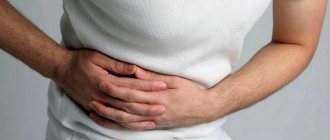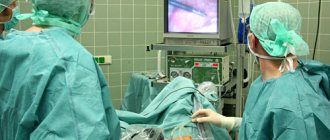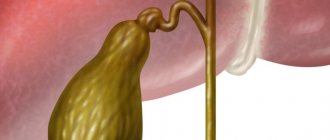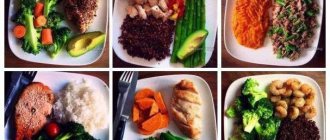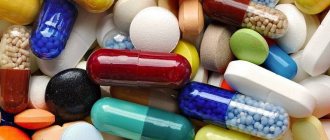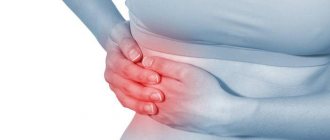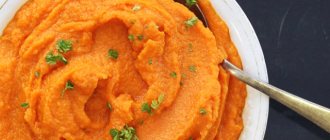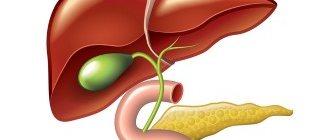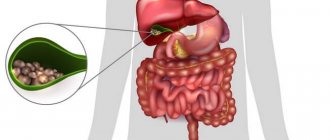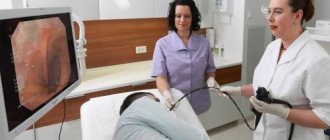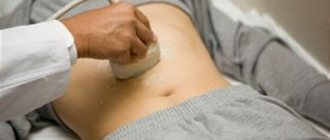Why does bilious diarrhea occur?
Diarrhea with bile in adults appears due to dysfunction of the gallbladder, biliary tract, liver, and gastrointestinal tract. There are several reasons that contribute to the appearance of bilious diarrhea:
- Viral, infectious diseases.
- Violation of the intestinal microflora, that is, dysbiosis. At the same time, pathogenic microbes predominate in the intestines, disrupting the functioning of the gastrointestinal tract. As a result, the bile produced by the body is not properly processed, turning the stool yellow.
- Food poisoning. At the same time, bile also does not have time to be processed by the intestines due to an increase in its contractile function and the rapid movement of food.
- Alcohol intoxication, which leads to damage to the body by poisons and disruption of the digestive system.
- Excessive consumption of fatty foods, which increases intestinal motility, causing loose stools.
- Crohn's disease, which is an inflammatory disease of the digestive system characterized by the formation of granulomas - nodules that resemble a benign tumor.
- Resection (removal) of any part of the intestine.
- Gallbladder diseases. This may be cholelithiasis, tumors, cholecystitis and other pathologies that lead to disruption of the functioning of this organ.
- Removal of the gallbladder (cholecystectomy).
Biliary diarrhea resulting from dysfunction of the gallbladder is called hologenic diarrhea.
Reasons for education
The main cause of diarrhea in pancreatitis is the prolonged course of the inflammatory process in the body. As a result, there is a disruption in the absorption of pancreatic enzymes and the functioning of the pancreas.
With a lack of active enzymes, the process of food digestion is disrupted and, against the background of acute pancreatitis, biliary dyskinesia occurs. Additional diseases of the gastrointestinal tract (cholecystitis, gastritis, colitis) also develop.
Bile performs an important function in the body and is responsible for the process of digesting food. When the functioning of most abdominal organs is disrupted, general discomfort occurs, which leads to stool upset and the development of intestinal dysbiosis.
The occurrence of diarrhea can be caused by the following provoking factors:
- Various infections and intestinal damage by pathogenic bacteria that negatively affect normal microflora;
- Vascular pathologies affecting the kinetic functions of the digestive system;
- Mechanical damage to the pancreas (wound, strong blow);
- Impaired functioning of the liver, gall bladder (formation of stones);
- Long-term use of potent chemical drugs (for example, medications for the treatment of cholecystitis).
Ways to prevent diarrhea after surgery
Cholecystectomy is a surgical procedure involving the removal of the gallbladder. Many people who have undergone this operation wonder why bilious diarrhea occurs after cholecystectomy. The thing is that bile is produced by the liver and then enters the gallbladder, from where it flows into the duodenum during meals.
After removal of the gallbladder, this process is disrupted, the secretion of bile directly from the hepatic ducts now occurs constantly, which is why loose stools occur. In addition, it is less concentrated, which means it does not have the necessary effect on fats for their breakdown, that is, it does not have its main function to the proper extent, which is why loose stools with bile appear if you do not follow the instructions, namely, follow a diet:
- eat small portions;
- exclude fatty foods from the diet;
- The intervals between meals should not be long, a maximum of five hours.
Failure to follow these recommendations leads to irritation of the intestinal walls, increased peristalsis and the appearance of loose stools with bile.
As already described above, the gallbladder is an organ in which the secretion secreted by the liver accumulates, that is, bile, the amount of which ranges from one to two liters per day (it all depends on body weight). Accumulating in the bladder, bile acid becomes more concentrated, and as a result of food intake, it is released into the intestines, where it participates in the digestive processes, or rather in the breakdown of fats obtained from food.
immunoglobulins, cholesterol, bilirubin, mucus, phospholipids, amino acids, proteins and vitamins. Their bilirubin is responsible for the color of stool. It has a yellow tint, which during normal digestion is transformed into a substance that gives stool a brown color. If digestive function is impaired, bilirubin is excreted unprocessed.
The digestion process itself occurs in several stages: the breakdown of fats in the proximal intestine into acids, from which they are converted into other chemical compounds vital for the body - fat-soluble vitamins, microelements. That is, normally processed bile should enter the body, absorbed through the blood, and only part of it should be excreted with feces.
First of all, fried foods should be excluded from the diet. Food needs to be steamed, stewed or boiled. It is recommended to focus on protein foods, such as boiled meat, chicken, steamed fish, soft-boiled eggs or steamed omelet. Also, for diarrhea, it is recommended to eat mucous porridge with water - rice, oatmeal.
https://www.youtube.com/watch?v=6dqXOqmjbhw
They have the property of enveloping the walls of the digestive tract, protecting against the harmful effects of toxins. In addition, the body needs sufficient vitamins and minerals. For this, it is good to use boiled or baked vegetables and fruits; baked apples are especially recommended, containing pectin, which is necessary to restore the functions of the intestines and the whole body.
You can also cook soups in vegetable, meat, or fish broth. To improve intestinal function, you need to restore its microflora; for this you can eat low-fat fermented milk products, cottage cheese, and cheese. Prohibited foods include: carbonated drinks, sweets, flour products, milk, fresh fruits and vegetables.
Food intake should occur every five hours in small volumes - no more than 250 grams at a time. Food should be consumed pureed; it should not be spicy, cold or hot, so as not to irritate the gastrointestinal mucosa. As your condition improves, you can gradually introduce familiar foods into your diet, but not fatty ones.
In addition to following a diet and nutrition regimen, what should you do to recover after cholecystectomy? Physical activity plays a big role in this. Excessive physical activity after surgery is unacceptable, since it increases intestinal contractility and provokes the appearance of loose stools.
Prohibited physical activity includes lifting a load of more than five kilograms, walking for more than one hour, running, jumping, this leads to an increase in pressure in the abdominal cavity. Permitted exercise includes: walking no more than forty minutes a day, breathing exercises. An increase in physical activity should occur no earlier than eight months after surgery and only with the permission of the attending physician.
After surgery, you need to change your lifestyle and eliminate poor nutrition. To prevent the development of hologenic diarrhea, following simple rules and doctor’s advice will help. These principles include the following recommendations:
- pay attention to portion sizes;
- frequent meals up to 6 times a day;
- monitor the fat content in dishes and products;
- adhere to a therapeutic diet.
After removing part of the intestine, the presence of bile can be observed in the stool. This process is called hologenic diarrhea, and this condition requires treatment. After resection, the patient needs to adhere to proper nutrition and eat healthy foods. It is worth noting that after removal of the gallbladder, the body will get used to the changes. Therefore, the patient needs to help his body.
How to stop diarrhea if you have gallbladder disease
Diarrhea due to gallbladder diseases and cholecystitis can be prolonged. In this case, intensive therapy is required. Pharmacy medications are used to normalize bile secretion or eliminate its excess. The best option is to prevent recurrent diarrhea. Adjust the diet and stick to it constantly. And if there is a need to break the rules of nutrition, you can use medications to normalize digestion.
Pharmacy drugs
From pharmaceutical drugs for hologenic diarrhea, choleretic drugs are prescribed. They stimulate the evacuation of bile from the bladder due to its contraction, and enhance bile formation in cholecystitis. They are used during meals for normal digestion and absorption of food. This promotes normal fecal formation, eliminates diarrhea and normalizes the motor activity of the biliary tract.
Diarrhea associated with cholecystitis can be eliminated with choleretic drugs:
- Oxafenadine;
- Nikodin;
- Flamin for diarrhea;
- Holosas;
- Gepabene.
The course of treatment with these drugs is from 2 to 4 weeks. If necessary, the attending physician can extend the course or repeat it. You cannot self-prescribe medications for diarrhea due to cholecystitis. Before using them, you must undergo a full examination and tests. Duodenal intubation may be performed to determine the functional activity of the biliary system. Dosages of medications are prescribed only by the attending physician.
The drug Gepabene allows you to relieve spasm of the sphincters of the bladder and ducts, normalizes the functioning of liver hepatocytes. Improves the qualitative composition of bile in case of cholecystitis, has hepatoprotective properties. The drug binds free radicals and promotes the regeneration of liver tissue. By normalizing the exchange of bile acids, it eliminates diarrhea.
Antispasmodics are used. They reduce the tone of smooth muscles during cholecystitis, relaxing the sphincters of the biliary tract.
An absolute contraindication to the use of these drugs is the stage of exacerbation of the disease.
Among other pharmaceutical drugs, sorbents are used to treat diarrhea. They are important to use between meals to eliminate excess bile during cholecystitis. They contain substances that, like a sponge, absorb toxins, bile acids, food particles and more, then are removed from the body. Some of them have protective properties, enveloping the mucous membrane.
If signs of dysbiosis and diarrhea appear, antibacterial drugs and probiotics are prescribed. Probiotics used:
- Linux;
- Bificol;
- Bifiform for cholecystitis;
- Simbiter et al.
When stones are formed mainly from cholesterol, conservative treatment is used. The drugs used are Ursofalk, Henofalk or Ursohol. They help dissolve stones by reducing cholesterol secretion. This may reduce diarrhea due to gallstones.
Change food
The ideal is considered to be dietary table number 5. This diet involves split meals for cholecystitis. Only 5-6 meals per day. The total fat content in the diet is reduced to 80 g, foods that cause intestinal irritation.
Excluded from the diet during diarrhea:
- flour;
- fatty meat, fish;
- mushrooms, legumes;
- radish, garlic, hot seasonings;
- smoked dishes, canned food, pickles;
- sausages are not recommended for cholecystitis;
- products containing oxalic acid (sorrel, spinach, beets, etc.);
- cold drinks, ice cream, soda, and black coffee can make diarrhea worse;
- chocolate.
Preference for cholecystitis is given to boiled and fresh foods. It is desirable that they be natural.
Every day you need to drink 1.5-2.0 liters of clean water. Such a diet will allow you to maintain a constant weight and reduce the frequency of relapses of cholecystitis and eliminate diarrhea.
Other
In case of frequent exacerbations and large stone sizes, surgical removal of the bladder is recommended. A thorough diagnosis of the gastrointestinal tract is carried out. Surgery for cholecystitis is performed using the laparoscopic method or open method. This will eliminate the threat of acute inflammation with the development of a number of complications and reduce the manifestations of diarrhea.
An active lifestyle is included in maintenance therapy for cholecystitis. Sports or physical exercise help normalize intestinal motility. The benefits of an active lifestyle include the prevention of obesity and liver problems, diarrhea, which has a beneficial effect on health. The fight against obesity is an important point in the maintenance therapy of chronic cholecystitis. Obesity leads to an increase in the lithogenic properties of bile and accelerates the development of cholelithiasis.
The article was approved by the editors
Chronic diarrhea
The disease develops gradually; in the first stages there are no symptoms, including diarrhea. The longer the illness lasts, the worse the gallbladder works. There are either too many bile acids or too little, which leads to intestinal dysfunction. Loose stools with cholecystitis are combined with periodic constipation - this is a characteristic sign of the chronic form. Feces in chronic cholecystitis are accompanied by a foul odor. May include mucus and fat.
During pregnancy, the gallbladder is compressed, which entails consequences that manifest themselves over time;
Loose stools are a sign not only of a poor diet, but also of its imbalance. Girls more often use diets without consulting a specialist; strict restrictions and lack of any microelements greatly affect the body and the functioning of the gallbladder;
Chronic cholecystitis itself, diarrhea, which is a common occurrence, can be provoked by the hormonal background of the female body (progesterone and other elements).
If you ignore the disease, all symptoms may intensify (exacerbation).
The appearance of loose stools during acute inflammation of the gallbladder is explained by the formation of stones. They not only disrupt the secretion of bile, but also cause severe, unbearable pain. The pain symptom is associated with the movement of stones or clots of mucus through the ducts. Diarrhea is the first symptom of gallstone disease.
Most often, this condition is observed in older people, but diarrhea due to the gallbladder in this case will not be considered the main symptom. The first two places will be taken by specific pain and cholelithiasis. Appears after eating (fatty, fried and similar foods), it can also develop against the background of not only the appearance of stones, but also with biliary dyskinesia (BD).
Ignoring this problem will lead to the following complications:
- Bubble rupture (perforation);
- Peritonitis;
- Mechanical (obturacin) jaundice;
- Acute pancreatitis (inflammation of the pancreas);
- The following will also appear:
- Chills;
- Sweating;
- Increased pain;
- Diarrhea with cholecystitis.
Treatment will involve not only eliminating symptoms, but also therapy aimed at eliminating the underlying cause.
Possible complications and consequences
The most serious complication of prolonged diarrhea due to pancreatitis is dehydration (removal of excess moisture from the body). As a result, there is a disturbance in the electrolyte-water balance and disruption of the functioning of many vital systems of the body.
This condition is marked by a significant deterioration in the general condition of hair, teeth, the appearance of muscle weakness, cracks in the lips and severe inflammation of the tongue (the phenomenon of glossitis). The patient quickly loses weight, and the general indicators of the body rapidly fall.
Against the background of such symptoms, there is a significant decrease in immunity and the development of concomitant diseases. With a long course of the disease, internal organs lose their functionality and decrease in size, which gradually leads to tissue necrosis. Changes in the functioning of the pancreas are most often the cause of the development of diabetes.
Bile diarrhea in a child
https://www.youtube.com/watch?v=Y6AEZiaKIWI
Diarrhea with bile occurs in adults when problems occur in the liver and gastrointestinal tract. Factors causing loose stools with bile in an adult are:
- bacterial and viral infections;
- microflora disturbance;
- food poisoning;
- binge eating;
- frequent consumption of fatty foods;
- diseases of the digestive system;
- after removal of part of the intestine;
- gallbladder diseases;
- cholecystectomy and removal of the gallbladder.
Viruses and bacteria can easily enter the intestines and begin to multiply due to reduced immunity. Infections lead to disruption of digestive function. Viruses provide a strong burden that the produced bile remains in the intestines for digestion. Therefore, the stool turns yellowish.
In most cases, diarrhea with bile appears after food poisoning. In this case, not only diarrhea occurs, but also vomiting. This portends inadequate processing of bile. When poisoning of the body and intoxication occurs, the intestines do not have enough time to digest. This occurs due to frequent contractions of the digestive tract.
Crohn's disease causes inflammation of the digestive system. Formations appear that are similar to a benign tumor. In case of serious diseases of the digestive organs, resection is performed. This causes diarrhea with bile.
Sometimes gallbladder diseases become a factor in the appearance of loose yellow stools. This process includes cholelithiasis. The occurrence of yellow diarrhea is associated with the manifestation of cholecystitis and tumor formations. As a result of complications, biliary pancreatitis is observed, which leads to a deterioration in secretion. Even with the gallbladder removed, diarrhea appears within normal limits.
Most often, diarrhea with bile occurs in diseases of the gallbladder - cholecystitis (its inflammation) or dyskinesia of the biliary tract - a change in their tone, in which both a delay in the excretion of bile and a condition that can most easily be compared with incontinence can develop: in this case, bile is free pours into the intestinal lumen.
Other causes of bilious diarrhea are related to the small intestine. This may include short small bowel syndrome, short ileum syndrome, or Crohn's disease. These are serious diseases that have a chronic course.
Diarrhea with bile can occur after removal of the gallbladder or part of the intestine, especially if there are errors in the diet. But the patient is usually warned about such conditions upon discharge.
Inclusions of bile in liquid feces can periodically occur during exacerbation of chronic diseases of the digestive system. An approximate diagram of this condition is as follows: a person eats something that stimulates the release of bile. For example, fatty or spicy. The burning liquid splashes into the intestines, the walls of which are inflamed and ready to accept bile only in doses. A large amount of this digestive juice irritates them, and sensations of pain, burning, and spasms appear in the liver area and lower abdomen on the right.
The body, believing that something harmful has entered the intestines, tries to remove the dangerous substance out as quickly as possible, delivering a large amount of water into the intestines, and diarrhea with bile occurs. The same process occurs during acute inflammation of the intestines, which can occur with some poisonings.
If bilious diarrhea occurs once or goes away within one day, it is most likely associated with a simple diet violation. However, even such a small thing is a reason to think about your health. Does your right hypochondrium hurt after fatty foods and heavy meals? Is there bitterness in the mouth, nausea, or heartburn?
In children under 2 months of age, a large amount of bile in the stool is normal, since their digestive system has not yet adjusted to food intake. But after this age, frequent yellowish or greenish stools are a reason to consult a pediatrician.
Proper diet is the main preventative measure
The only way to prevent unpleasant attacks of diarrhea due to cholecystitis is to review your diet and adhere to basic nutritional rules. It is not recommended to organize the menu on your own - it is better to go to a nutritionist who will help you create a list of dishes that will prevent intestinal upset. It is recommended to exclude the following products or dishes from the menu:
- fatty meats;
- smoked meats, pickles, marinades;
- carbonated sweet drinks;
- conservation;
- chocolate, sweets;
- sweet products, baked goods with cocoa.
Fractional nutrition in small portions will allow the digestive organs to normalize metabolic processes, which will partially prevent intestinal disorders. Be sure to take food warm - hot or cold foods will cause additional problems. Drink up to 2 liters of liquid throughout the day. Prolonged diarrhea can cause dehydration, which can lead to dangerous health complications.
It is quite possible to cope with loose stools that occur due to cholecystitis, but doctors warn that without prior consultation with a specialist, there is a risk of causing health-threatening complications. Diarrhea is usually a consequence of an advanced disease, so experiments, independent use of aggressive pharmaceutical drugs or herbal decoctions are a sure way to problems that will require lengthy and not always effective treatment to eliminate.
Moderate physical activity has a beneficial effect on the functioning of the gallbladder and the entire gastrointestinal tract:
- walking in the fresh air;
- swimming in the pool;
- physiotherapy;
- maintaining an active lifestyle.
To prevent future diarrhea, it is recommended:
- Visit your doctor in a timely manner and monitor the condition of the gallbladder and other organs.
- Do not choose medications yourself.
- Get rid of bad habits.
- Avoid stress.
What medications can you take?
If you suspect diarrhea due to cholecystitis, a gastroenterologist will tell you what to do. Without consultation with a treating specialist, drastic measures should not be taken. All you can do yourself is to provide first aid:
- Take a horizontal position;
- Apply a cold compress to the sore spot;
- Call emergency medical assistance;
- You can use an adsorbent drug that will help reduce symptoms such as diarrhea (Smecta, Atoxil, Enterosgel). It is important that the interval between taking drugs of this group and any other medication should be at least 2 hours.
Take an antispasmodic (No-Shpa) and an anesthetic (Analgin, Baralgin, Ibuprofen, Nimid).
If you have diarrhea due to biliary dyskinesia, only a specialist can tell you how to treat it correctly, but antispasmodics are used for such purposes.
Once a diagnosis has been made, treatment can take two forms:
- Surgical (the bladder is completely removed);
- Conservative.
Appointed:
- Antispasmodics: No-Shpa, Papaverine;
- Choleretic: Allohol, Hologon, Decholin;
- Antibiotics and anti-inflammatory depending on the underlying cause.
In addition, the following are excluded from the diet:
- Fatty, smoked, heavy foods;
- Canned food;
- Cocoa;
- Chocolate;
- Alcohol;
- Sweet carbonated drinks.
You need to eat 5-6 times a day in small portions and drink at least 2 liters of water.
It is possible to cure diarrhea in cholecystitis, however, in 20% of cases it is a very advanced form of the disease. Do not delay in contacting a doctor and this problem will be solved much easier and faster, without the intervention of a surgeon.
If the patient is diagnosed with acute or confirmed symptoms of chronic cholecystitis in the acute stage, then treatment in the surgical department of the hospital is recommended. The treatment method is selected according to the form of the disease and the individual characteristics of the patient’s body. In some cases, conservative treatment is resorted to, which includes:
- the use of antibiotics, which are selected according to the indications and effectiveness of the drug;
- taking antispasmodics in order to normalize the process of excretion of bile into the small intestine;
- prescribing choleretic drugs if the patient has hypotension and the patency of the bile duct is impaired;
- hepatoprotectors if there is liver dysfunction.
Surgical intervention may involve the use of cholecystectomy - this is when the gallbladder is completely removed. Immediate surgery should be performed if the patient has developed diffuse peritonitis and acute bile obstruction; in other situations, operations are carried out as planned.
As for medications, you can give the patient some sorbent, for example, Smecta or Atoxil. This will reduce the occurrence of diarrhea. Make sure that taking this drug does not coincide with taking other medications, otherwise the effectiveness of the latter will be significantly reduced. In case of severe pain, you can take No-shpa, Analgin or Ibuprofen.
In the modern world, there is an increase in gastrointestinal morbidity, which greatly reduces a person’s quality of life. More and more doctors are diagnosing gastritis, which affects people of all ages. Depending on the type of illness, specialists select special treatment and a special diet.
Sorbents. Allows the body to remove toxins produced by microbes or from food. Medicines absorb unwanted substances and are excreted from the body in feces. Sorbents have a binding effect. The use of products in this category is undesirable for inflammation of the mucous membranes of the digestive tract. Accordingly, we refuse Enterosgel, activated carbon, silicon dioxide, Atoxil.
Drugs that suppress intestinal motility, for example, the drugs Loperamide, Imodium. They act on the nerve endings of the intestinal walls, reducing peristalsis. As a result, feces pass through the lumen more slowly, and diarrhea stops.
Antimicrobial agents, for example, Nifuroxazide and Levomycetin tablets. They will act on diarrhea caused by uncontrolled proliferation of microbes. Pathogenic bacteria include Protea, Klebsiella, rotavirus, Pseudomonas aeruginosa, and Salmonella.
Enzymes. Doctors recommend Mezim, Creon, and Festal tablets. They will help if the cause of loose stools due to cholecystitis lies in parallel insufficiency of pancreatic function. The group's preparations contain enzymes extracted from the glands of pigs and cattle. The drugs are prescribed temporarily or for life.
Drugs for restoring motor skills. Affects the enkephalinergic system of the digestive tract. Normalize peristalsis, eliminating diarrhea, constipation, flatulence. Trimedat, Meteospasmil are recommended.
Probiotics such as powders “Linex”, “Bifiform”, “Lactiale”. They contain strains of beneficial microorganisms.
Prebiotics, for example, Hilak-Forte drops. Create favorable conditions for the growth of bacteria from probiotics.
The use of drugs normalizes the composition of intestinal microflora and eliminates diarrhea. However, you should not expect quick results. Only a doctor can select effective medications for the treatment of disorders associated with inflammation of the gallbladder.
If the complex does not help, you need to undergo examination to identify other health problems. First, the patient undergoes an ultrasound (ultrasound examination) of the abdominal organs, which will show visual deviations in the structure of the digestive tract and the presence of pathological formations.
Detailed and biochemical blood tests will reveal the inflammatory process and anemia. The level of eosinophils is needed to diagnose allergies or parasitic diseases. Increased levels of ALT (alanine aminotransferase) and AST (aspartate aminotransferase) indicate liver disease. High cholesterol levels are often a sign of gallbladder problems.
Elevated values of ESR (erythrocyte sedimentation rate) and leukocytes in combination with low hemoglobin indicate the likelihood of internal bleeding and often indicate oncology.
If the cause of diarrhea cannot be determined, the diagnosis is supplemented with:
- CT (computed tomography).
- MRI (magnetic resonance imaging).
- By fluoroscopy.
- Colonoscopy.
- Ultrasound of the intestines.
Depending on concomitant pathologies, the therapeutic regimen includes:
- antacids;
- enzymes;
- painkillers and anti-inflammatory drugs;
- antimycotics.
If there are mechanical barriers that disrupt the flow of bile and lead to inflammation, surgical intervention is performed. Preference is given to minimally invasive laparoscopic methods.
Cancer is eliminated with:
- operations;
- chemical and radiation therapy;
- embolization (disruption of blood supply to the tumor).
Therapy begins with eliminating symptoms. In some cases, diagnosis for loose stools is not required. Especially if a resection was performed. After the operation, the doctor gives specific actions so that the patient does not experience complications. However, prevention and treatment consist of proper nutrition and diet in the first weeks. If hologenic diarrhea occurs with complications, then medications are prescribed.
If, during resection, there is an imbalance of positive agents or an infection has entered the body, then antibacterial agents are prescribed. To restore intestinal microflora, medications containing lactobacilli, probiotics and prebiotics are prescribed. The following medications help:
- Linux;
- Bifiform;
- Normabakt.
The course of drug treatment is 2 weeks. However, for some people it depends on the individual. The patient should not self-medicate and take choleretic drugs.
Therapeutic diet
Proper nutrition for hologenic diarrhea is considered the main principle of treatment. Doctors say that meals should not consist only of plant products. The diet needs to be varied. Therefore, it is allowed to include low-fat kefir and cottage cheese, dietary fish, soft-boiled eggs, turkey and chicken meat in the diet.
At the same time, you should not eat any sweet foods and baked goods, sour fruits and berries, fatty foods and fried foods. It is worth highlighting that with hologenic diarrhea you should not take alcohol-containing drinks.
For hologenic diarrhea, 1 serving should not exceed 1 glass. When the condition improves, you need to discuss with your doctor an expansion of the diet of permitted foods. When loose stools are observed, you need to drink 2 liters of liquid per day. If diarrhea occurs, increase the volume of water consumed. This will help avoid dehydration.
If biliary diarrhea is detected, restoration of the gastrointestinal tract is required. If diarrhea was provoked by cholecystectomy, then it is necessary to urgently stop the release of bile. To do this, it is necessary to carry out a number of activities. First of all, it is necessary to start a course of choleretic medications.
To eliminate abdominal cramps, Gepabene is prescribed. Sorbents play an important role. These include activated carbon, Enterosgel, Smecta. If there is a suspicion of an intestinal infection, Nifuroxazide is prescribed. To restore the microflora, probiotics are indicated - Linex, Bifiform. If part of the intestine has been resected, diarrhea is treated with Octreotide. Loose stools with bile impurities are eliminated with Cholestyramine.
- Take two tablespoons of rowan juice half an hour before meals, twice a day. Rowan has pronounced antimicrobial and astringent properties. It is a source of vitamins, organic acids, pectins and other beneficial substances that have a beneficial effect on the functioning of the digestive system.
- Grind one medium pear, pour a glass of boiling water, leave, covered, for six hours. The drug is drunk 50 milligrams half an hour before meals. This product perfectly fixes stool, contains many useful substances, and has an antimicrobial effect. In addition, it strengthens the body's protective functions, helping to fight the disease.
- Grind wheatgrass roots in a coffee grinder and consume every few hours with water. The dosage of the powder is at the tip of a spoon.
Acute cholecystitis and diarrhea (diarrhea), what is it?
This type of disease is considered a serious complication of gallstone disease, which develops gradually progressing. On the walls of the gallbladder, cholesterol, bilirubin, and calcium salts are deposited in the form of flake-like structures. Over time, their volume increases, stones are formed, disrupting the process of natural outflow of bile. This process leads to dangerous changes in the vascular tissues of the gallbladder, which can cause damage in the form of perforations or areas of necrotic tissue. Often this situation requires prompt surgical intervention.
Subtypes of acute cholecystitis:
1 Catarrhal. Inflammation mainly affects the internal cavity of the gallbladder, without spreading to surrounding tissues. It is expressed in regular pain of moderate intensity under the ribs on the right and epigastrium, which radiates to the lumbar region, as well as to the right shoulder and scapula.
2 Phlegmonous. It is characterized by pronounced symptoms. The pain is very severe, attacks intensify with the act of deep breathing and the slightest movement. There is nausea and sometimes vomiting. The abdomen is tense, tachycardia and increased body temperature are noted. Nearby tissues are involved in the inflammatory process.
3 Gangrenous. It is characterized by a rapid increase in the totality of symptoms.
The main provoking factors for inflammation of the gallbladder are considered to be a disrupted order of bile outflow and the presence of infection in the biliary tract. Penetration of pathogens into the cavity of the gallbladder is possible due to their entry with lymph and blood, intestinal microflora inhabited by pathogenic organisms.
Acute cholecystitis can cause a number of serious complications, including:
1 abscess formation;
2 formation of peri-vesical infiltrate;
3 inflammation in the bile ducts (cholangitis);
4 pancreatitis (inflammation of pancreatic tissue);
5 perforation of gallbladder tissue;
6 peritonitis resulting from perforation of the walls of the gallbladder.
Causes of diarrhea with bile
When severe diarrhea with bile occurs, it always alarms a person, but doctors give a completely understandable explanation for this condition. This intestinal disorder is called biliary or hologenic diarrhea. In this case, there is a change in the color of the stool, which is caused by the release of bile into the intestines.
Bile must enter the stomach to break down fats from incoming food. If there is a pathology in the body, bile fluid begins to be produced involuntarily and irritate the intestinal mucosa. As a result, diarrhea with bile develops. Its excessive content leads to disruption of the secretory process. Feces become yellow in color due to bile secretions. The main reasons include the following factors:
- Infectious or viral diseases;
- Disturbance of the balance of intestinal microflora as a result of the activity of pathogenic microorganisms. Under their influence, bile is not processed by enzymes and comes out in its original form;
- Food poisoning. The process is characterized by too rapid passage of food through the digestive tract, at which time the bile fluid simply does not have time to be processed;
- Poisoning as a result of excessive consumption of alcoholic beverages. In this case, diarrhea with bile is observed after alcohol. The condition does not require special treatment, so the body is simply trying to urgently get rid of toxins. After bowel movement, the functioning of the gastrointestinal tract will restore itself;
- Increased consumption of fatty foods. There is a disruption of intestinal motility. The condition is almost always accompanied by bilious diarrhea;
- Crohn's disease. In this case, granulomas begin to develop in the gastrointestinal tract, which interfere with the functioning of organs and disrupt the normal formation of feces;
- Surgical intervention in the iliac region;
- Cholecystectomy is the removal of the gallbladder, which is the first cause of biliary diarrhea;
- Diseases localized in the gallbladder (cholecystitis, presence of stones, tumor). Pathologies disrupt the functioning of the organ;
- Congenital anomalies of the gallbladder that interfere with its functioning;
- Celiac disease is a pathology characterized by the absence of contractile function of the gallbladder.
Among the wide range of causes of the disease, it is impossible to independently determine the cause without special tests and studies. Treatment requires medical assistance.
They, of course, can be completely different, but in most cases the provoking factor is the formation of stones in the cystic duct and other places of the gallbladder, which create an insurmountable obstacle to the release of bile. In addition, the causes of the disease can be various types of injuries or infections, as well as serious diseases such as diabetes. But in this case, cholecystitis is already a complicated consequence of the pathology that exists, and not in the form of an independent disease.
Everything that was listed above can result in an acute form of the disease with the development of inflammatory processes in the gallbladder. As for the chronic course of the disease, this form of the disease, as a rule, manifests itself in situations where the irritating factor, remaining, takes on a protracted nature, ultimately leading to thickening of the walls of the organ.
In the practice of gastroenterologists, there is also such a sign of acute cholecystitis as repeated stools with a liquid consistency and inclusions of mucus. When the symptom of diarrhea is pronounced, doctors often make a diagnosis corresponding to foodborne toxic infection. Diarrhea due to cholecystitis causes many medical errors when making a diagnosis. But intoxication phenomena in the body can be associated with inflammation in the gallbladder.
In addition to the presence of diarrhea in various forms of cholecystitis, errors in diagnosis are also caused by the presence of other symptoms, for example, the presence of severe chest pain. This situation can be observed in the cardiac form of cholecystitis, which is considered an atypical type of disease, described by S. P. Botkin and called cholecystocoronary syndrome. A feature of this disease is the absence of stones. It is accompanied by hepatitis, inflammation of the pancreas and bile ducts.
Bilious loose stools and diarrhea are liquid bowel movements in which feces contain bile, which makes them yellow in color. In young children who have not even reached the age of one, diarrhea with bile is the norm. Its appearance is explained by the peculiarities of the digestive system adapting to the external environment.
At the same time, in adults, the appearance of bilious diarrhea is a sign of pathological processes in the body. Liquid stool containing bile inclusions is observed in adults due to problems with the liver, gallbladder or its ducts, and the digestive system as a whole. Infections and viral diseases can cause severe water diarrhea.
The liver of a healthy person produces bile, which then moves into the gallbladder, and from it, during meals, into the duodenum. When the above organ is removed, the natural process is disrupted, and bile is released directly and continuously from the liver, which causes diarrhea.
The presence of problems in the body can be diagnosed by the appearance of human excrement, its consistency and composition. The stool of an absolutely healthy person may only be yellowish-brown in color. If the yellow color predominates, this is a sure sign of the presence of bile in the biological mass, which may indicate serious disturbances in the functioning of some internal organs.
When a healthy person experiences pain in the abdomen or anus for no apparent reason, it can be rightfully noted that these are the first symptoms of a serious illness. Any inflammation, especially of the colon, begins and develops gradually.
As a rule, diagnosis and treatment begin from the moment when the manifestation of pathology does not allow one to lead a normal lifestyle. Only then does the sick person begin to be active in order to correct the situation. Prolonged neglect of colon inflammation always leads to serious consequences.
This kind of behavior is explained by the sensitivity of the problem. Many people, especially men, prefer not to see a doctor, but to carry out treatment with folk remedies. Symptoms such as diarrhea, abdominal pain, fever are considered insignificant and can be easily eliminated. In fact, the situation is more serious.
The gallbladder is an organ that stores bile produced by the liver for release into the intestines at the right time. For normal digestion, it is necessary that bile enters the small intestine during food intake, and not when it is synthesized in the liver.
With insufficient activity of the biliary tract, bile is supplied to the small intestine at the wrong time. Food in the intestines is only partially absorbed and enters the large intestine undigested. Here it begins to decompose under the influence of putrefactive bacteria. The result is diarrhea with a strong foul odor.
With cholelithiasis, putty-like bile is formed. The main components of bile turn into stones in the cavity of the gallbladder. They usually have a mixed composition, but predominantly contain cholesterol. Stones are most often accompanied by diarrhea that is unnaturally light in color and has a strong odor.
Diarrhea due to inflammation of the gallbladder is observed when the acute form transitions to chronic. In this case, diarrhea periodically gives way to constipation, since the gallbladder is unstable and secretes either too little or too much bile.
Diarrhea due to cholecystitis is difficult to wash off the walls of the toilet. This phenomenon is due to the fact that the feces contain too much fat, which is not absorbed in the intestines.
The appearance of cholecystitis and accompanying diarrhea may be associated with other ailments or special conditions:
- Pregnancy. A growing fetus in the uterus leads to organ dysfunction. The gallbladder becomes compressed, cannot function normally, and diarrhea appears.
- Unbalanced diet. Insufficient amounts of proteins, fats or carbohydrates lead to disruption of the outflow of mucus and bile.
- Dysbacteriosis. Changes in intestinal microflora as a result of an infectious disease or its treatment can also stimulate the inflammatory process. In such cases, diarrhea disappears after the underlying disease is cured.
The main causes of loose stools with cholecystitis
It is not always only the disease that causes loose stools. The combination of cholecystitis with additional problems of the body usually leads to disturbances in metabolic processes, which results in prolonged diarrhea. The causes of diarrhea with cholecystitis are the following problems:
- Damage to the body by worms. Parasites that occupy the body often provoke complications in the functioning of the gallbladder.
- Microflora disorders. Infectious diseases, long-term treatment with antibacterial drugs destroys beneficial bacteria that normalize metabolic processes.
- Pregnancy. The developing fetus puts pressure on the bladder, and disruption of hormones affects the functioning of the digestive organs.
- Sedentary lifestyle. Lack of physical activity causes metabolic deterioration.
- Wrong diet. Indulging in junk food, rich in sweet ingredients, fat, and spices against the background of illness will certainly cause intestinal irritation.
Often the cause of chronic diarrhea is even heredity. The body refuses to absorb some elements, which results in loose stools.
Symptoms
Acute form:
- Severe pain in the right side of the abdomen. They radiate to the back and do not go away for quite a long time; they are observed closer to night and morning;
- Flatulence;
- Mild fever;
Chronic form:
- Pain in the right hypochondrium;
- Lack of appetite;
- Bitter belching.
Common to both forms:
- Yellow skin tone;
- Nausea;
- Vomit;
- Bitter taste in the mouth.
The main signs of disease or exacerbation of pathology include:
- bilious diarrhea;
- pain in the stomach or right hypochondrium;
- bitter taste in the mouth;
- stomach twists;
- nausea and vomiting, especially after eating fatty foods;
- bloating;
- spasms in the intestines.
To make an accurate diagnosis, it is recommended that you describe all the symptoms of your condition to your doctor as accurately as possible.
Associated symptoms
Cholecystitis is not always accompanied by diarrhea. However, in combination with other additional symptoms it can be a characteristic sign of the disease.
There are both general symptoms and specific ones characteristic of each form of inflammation.
Acute cholecystitis is characterized by:
- Flatulence is severe bloating and very painful.
- When the gallbladder is inflamed, the right side of the abdomen hurts very, unbearably, and diarrhea intensifies the pain. Colic begins abruptly and lasts longer than an hour.
- The disease causes not only diarrhea, but chills and fever.
The chronic form is accompanied by the following symptoms:
- There is a bitter taste in the mouth, and sometimes there is belching with a bitter taste.
- A dull aching pain appears in the right hypochondrium.
- Appetite worsens as food is not digested and becomes a source of toxins.
There are signs common to both forms:
- Light colored diarrhea.
- The gallbladder, if it does not fulfill its function, causes diarrhea, nausea, and vomiting;
- Often, when there is inflammation, bile clogs the ducts. Both acute and chronic cholecystitis in this case leads to yellowing of the sclera of the eyes and skin.
Important! An accurate diagnosis can only be made after an examination. The symptoms of cholecystitis and pancreatitis are very similar.
Treatment and prevention of the disease
Loose stools with cholecystitis are only a small part of the problem. Severe pain and digestive tract upset require immediate and effective treatment.
- To improve the secretion of bile, choleretic drugs are prescribed: Allohol, Decholin, Hologon.
- To relieve painful symptoms, the course includes antispasmodics: Papaverine, No-shpu. For the same purposes, painkillers are prescribed: Ibuprofen, Nimid.
- Depending on the causes of the illness, anti-inflammatory or antibacterial drugs are used.
- Diarrhea due to stones in the inflamed gall bladder is treated by prescribing sorbents: Smecta, Enterosgel.
Basics of drug treatment
To make an accurate diagnosis, the doctor prescribes tests such as a general analysis of blood, stool and urine.
A glucose test is also needed to determine whether the patient has developed pancreatogenic diabetes mellitus.
In addition, an ultrasound examination is performed to help determine how damaged the pancreas is.
Therapy is based on a special diet and medication. Nutrition plays an important role in the treatment of illness, so it is worth remembering. The main requirements for the patient’s diet are:
- drink at least 2 liters of water daily;
- eat food in small portions, but often;
- avoidance of fried, fatty, salty and pickled foods;
- Food should be cooked boiled, baked or steamed;
- the temperature of the dish should not be higher than 39 degrees;
- to refuse from bad habits.
In acute cases of the disease, fasting for pancreatitis will be beneficial. But this method should be used only after consultation with your doctor.
Without drug therapy, it is impossible to get rid of the disease. The main task is to normalize the water-salt balance, as well as increase immunity. Thus, the problem of how to stop diarrhea with pancreatitis will disappear by itself. When treating the disease, the following drugs are prescribed:
- Enzymatic agents that facilitate the digestion process. These include Festal, Mezim and Pancreatin.
- Enterosorbents that eliminate toxic substances from the body. The most popular are activated carbon, Almagel, Polysorb.
- Medicines that increase the tone of the rectum and reduce the frequency of bowel movements. The most commonly used drugs are based on loperamide - Loperamide, Immodium and Lopedium.
- Medicines that eliminate pain (Baralgin) and spasms (Papaverine, No-shpa), and also have a complex effect – Renalgan, Spasmil.
- Probiotics that normalize intestinal microflora. These include Lactobacterin, Colibacterin, Baktistatin.
- Vitamin and mineral complexes that restore the body's defenses after illness. The most popular are Complivit, Supradin, Vitrum.
Before restoring immunity and beneficial microflora, it is very important to completely eliminate harmful organisms from the intestines. In this regard, cleansing enemas are performed.
Some drugs have certain contraindications associated with pancreatitis during pregnancy and the lactation period, which also needs to be taken into account.
Symptoms and signs of acute cholecystitis
Patients in the older age group (after 60 years) are more susceptible to acute cholecystitis. The disease is characterized by an acute initial period, accompanied by a sudden attack of severe pain localized in the area of the right hypochondrium. The pain does not subside, constantly tormenting the patient and forcing him to take an immobilized position. The presence of intense colic is explained by the movement of stones in the cavity of the bladder or clots of stagnant bile and mucus in the bile ducts.
Colic can last from minutes of pain to a multi-hour attack, and in some cases lasts for 2-3 days. Pain associated with inflammation in the gallbladder is characterized by its localization in the area on the right under the ribs, as well as its frequent cases of irradiation to areas of the right scapular region, shoulder, and lower back. The patient often experiences elevated body temperature and rapid heartbeat (tachycardia), with a heart rate of up to 130 per minute.
Classification of the disease
Cholecystitis can take both acute and chronic forms. In this regard, not only the symptoms differ, but also the mechanism of the disorder:
- The acute form of cholecystitis is associated with the formation of gallstones: they obstruct the outflow of bile, and the addition of an infection leads to swelling of the walls of the gallbladder and severe pain.
- The chronic form develops against the background of malnutrition, but is usually not accompanied by the appearance of stones. It is easier to treat.
